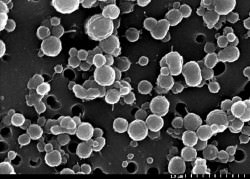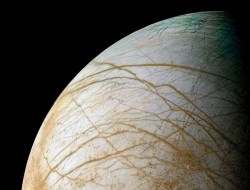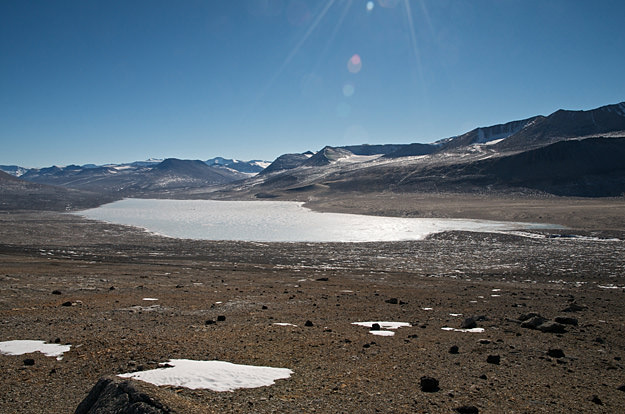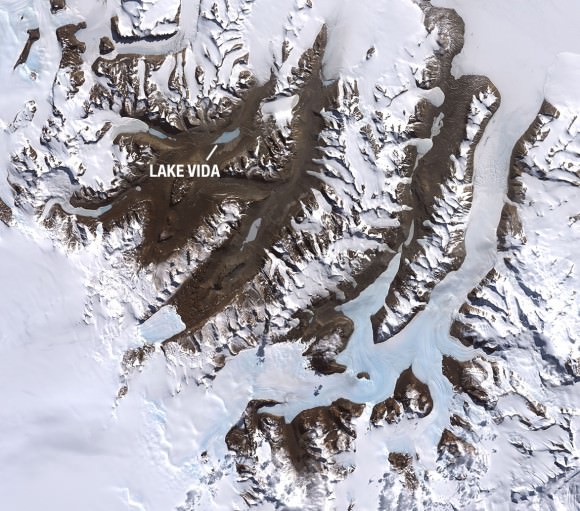Lake Vida lies within one of Antarctica’s cold, arid McMurdo Dry Valleys (Photo: Desert Research Institute)
Even inside an almost completely frozen lake within Antarctica’s inland dry valleys, in dark, salt-laden and sub-freezing water full of nitrous oxide, life thrives… offering a clue at what might one day be found in similar environments elsewhere in the Solar System.
Researchers from NASA, the Desert Research Institute in Nevada, the University of Illinois at Chicago and nine other institutions have discovered colonies of bacteria living in one of the most isolated places on Earth: Antarctica’s Lake Vida, located in Victoria Valley — one of the southern continent’s incredibly arid McMurdo Dry Valleys.
These organisms seem to be thriving despite the harsh conditions. Covered by 20 meters (65 feet) of ice, the water in Lake Vida is six times saltier than seawater and contains the highest levels of nitrous oxide ever found in a natural body of water. Sunlight doesn’t penetrate very far below the frozen surface, and due to the hypersaline conditions and pressure of the ice water temperatures can plunge to a frigid -13.5 ºC (8 ºF).
 Yet even within such a seemingly inhospitable environment Lake Vida is host to a “surprisingly diverse and abundant assemblage of bacteria” existing within water channels branching through the ice, separated from the sun’s energy and isolated from exterior influences for an estimated 3,000 years.
Yet even within such a seemingly inhospitable environment Lake Vida is host to a “surprisingly diverse and abundant assemblage of bacteria” existing within water channels branching through the ice, separated from the sun’s energy and isolated from exterior influences for an estimated 3,000 years.
Originally thought to be frozen solid, ground penetrating radar surveys in 1995 revealed a very salty liquid layer (a brine) underlying the lake’s year-round 20-meter-thick ice cover.
“This study provides a window into one of the most unique ecosystems on Earth,” said Dr. Alison Murray, one of the lead authors of the team’s paper, a molecular microbial ecologist and polar researcher and a member of 14 expeditions to the Southern Ocean and Antarctic continent. “Our knowledge of geochemical and microbial processes in lightless icy environments, especially at subzero temperatures, has been mostly unknown up until now. This work expands our understanding of the types of life that can survive in these isolated, cryoecosystems and how different strategies may be used to exist in such challenging environments.”
Sterile environments had to be set up within tents on Lake Vida’s surface so the researchers could be sure that the core samples they were drilling were pristine, and weren’t being contaminated with any introduced organisms.
According to a NASA press release, “geochemical analyses suggest chemical reactions between the brine and the underlying iron-rich sediments generate nitrous oxide and molecular hydrogen. The latter, in part, may provide the energy needed to support the brine’s diverse microbial life.”
“This system is probably the best analog we have for possible ecosystems in the subsurface waters of Saturn’s moon Enceladus and Jupiter’s moon Europa.”
– Chris McKay, co-author, NASA’s Ames Research Center
 What’s particularly exciting is the similarity between conditions found in ice-covered Antarctic lakes and those that could be found on other worlds in our Solar System. If life could survive in Lake Vida, as harsh and isolated as it is, could it also be found beneath the icy surface of Europa, or within the (hypothesized) subsurface oceans of Enceladus? And what about the ice caps of Mars? Might there be similar channels of super-salty liquid water running through Mars’ ice, with microbes eking out an existence on iron sediments?
What’s particularly exciting is the similarity between conditions found in ice-covered Antarctic lakes and those that could be found on other worlds in our Solar System. If life could survive in Lake Vida, as harsh and isolated as it is, could it also be found beneath the icy surface of Europa, or within the (hypothesized) subsurface oceans of Enceladus? And what about the ice caps of Mars? Might there be similar channels of super-salty liquid water running through Mars’ ice, with microbes eking out an existence on iron sediments?
“It’s plausible that a life-supporting energy source exists solely from the chemical reaction between anoxic salt water and the rock,” explained Dr. Christian Fritsen, a systems microbial ecologist and Research Professor in DRI’s Division of Earth and Ecosystem Sciences and co-author of the study.
“If that’s the case,” Murray added, “this gives us an entirely new framework for thinking of how life can be supported in cryoecosystems on earth and in other icy worlds of the universe.”
Read more: Europa’s Hidden Great Lakes May Harbor Life
More research is planned to study the chemical interactions between the sediment and the brine as well as the genetic makeup of the microbial communities themselves.
The research was published this week in the Proceedings of the National Academy of Science (PNAS). Read more on the DRI press release here, and watch a video below showing highlights from the field research.
Funding for the research was supported jointly by NSF and NASA. Images courtesy the Desert Research Institute. Dry valley image credit: NASA/Landsat. Europa image: NASA/Ted Stryk.)



Were scientists also sterilized?
Sterile labs are given classification levels – no doubt theirs was a level 2-3 or so. That means they’ll have been wearing, I hope, sterilized lab suites (Think Space-Suites :P) – or, at minimum, the sample will never have even come into contact with the outside air – being taken directly from the source to a air-tight microscope machine. Considering how deep the Ice was – they probably wanted to avoid anything diffusing into the water in case it killed the organisms within.
They’re quite careful, and if they’re not – well, they’re not worthy of being called scientists ^^
We just got our scientist neutered. He hates the cone-collar.
LMAO
Extremophiles aren’t really much of an indication that life can develop in harsh environments. It means life can adapt to harsh environments. There’s no reason to believe, at this point, that life doesn’t need someplace warm and cushy to actually spring into existence.
Thank you. I’ve been saying this for years. Just because life is somewhere on earth doesn’t mean it could originate there.
Doesn’t mean it couldn’t wither… that’s why this type of story always seems to include the word “COULD” as a caveat… “If life could survive in Lake Vida, as harsh and isolated as it is, could it also be found beneath the icy surface of Europa, or within the (hypothesized) subsurface oceans of Enceladus?” Why bother negating something that’s posed as a possibility only to begin with? …unless you’re s troll…
Doesn’t mean it couldn’t either… that’s why this type of story always seems to include the word “COULD” as a caveat… “If life could survive in Lake Vida, as harsh and isolated as it is, could it also be found beneath the icy surface of Europa, or within the (hypothesized) subsurface oceans of Enceladus?” Why bother negating something that’s posed as a possibility only to begin with? …unless you’re s troll…
Who’s trolling a number of similar comments? =D
More seriously, you are not reading the fine print while arguing over it. No one was “negating” the possibility, claiming it didn’t exist.
They were noting that it isn’t “really much of an indication” respectively that extremophile habitability doesn’t necessarily mean abiogenesis possibility.
Why are we bothering to do this? Because it is an old and sloppy argument to propose that extremophile habitability constrain the conditions of abiogenesis. It is likely more harmful than helpful outside the study of habitability, which isn’t the same thing as the study of inhabitation of biospheres.
“Doesn’t mean it couldn’t either”
No one can prove a negative statement.
Living the Lake Vida loca.
I can’t add much on the ice sharp analyses of earlier commenters. Except on the specifics: I would think that the complete absence of archaea (which is indicated but explicitly claimed on a microbiology site) is an indication that conditions were changing too fast for them as the frozen over lake was established.
Archaea are minimal energy specialists, but they are therefore also less able than bacteria to adapt to different environments. Maybe that is what we are seeing here.
As careful as they were, the ice sample was exposed to the air they were breathing…. which looks like heavy work in a ‘hot suit’? How many possible microbial contaminates in that?
Leaves room for possibilities in those Mercury craters too.
“This system is probably the best analog we have for possible ecosystems in the subsurface waters of Saturn’s moon Enceladus and Jupiter’s moon Europa.” _____________________________________________
Huge difference: this Planet is clothed in a Life-Fabric. It threads the entire surface, from deepest marine geography to highest alpine topography. SUB-ecosystems thrive under its radiation protected air-vault, and above life-balanced platforms: marine-systems over ocean floors, and continental superstructures, supporting land Life. Can any “isolated” life-colony – here ON EARTH – really be considered a stand-alone habitat? One may seem cut-off from the greater Life-Web, but still lie embedded within its encompassing whole.
This “cryoecosystem” (if not born of contamination) might appear separate, deep under an Antarctic ice-patch. Were its lake waters once unfrozen(?), and vibrant with ecosystem, tied-into the greater Global System: the Biosphere.
Do islands of life within its “hostile” recesses, of whatever scale, spontaneously emerge from, or out-of them? Lone patches of extreme existence, woven-around “Black Smoker” communities, on pressured floor of Ocean Ridges, or compressed under tons of polar-ice, in bacterium-thriving niches? Or, are these living oasis all tied-together – here ON EARTH: Sol’s Life-favored Planet.
Context is World of LIFE: it will always read – breed – LIFE (here, there and everywhere) – WITHIN its encircling dominion.
Gas giant moons are are naked – inhospitable for life – unclothed (absent even a suitable body for, or favorable place of, its attire). Subterranean promise of tidal warming, and/or interior heating, compressed in chambered “lakes”, or layered “oceans”, may turn-out a cold mirage. An unreal expectation, without very-dimensional, multilevel life, air-enveloped global support enclosure – a world-wrapping, animating biosphere.
A global Terrarium (“place of life”), where life produces life: biogenesis – tree produces seed, seed produces tree / life-preserving impregnation = birth of life’s continuation.
Hypothetical scenarios may read-out “life”. But real world demonstration, computes sterility – lifelessness – without a preserving, perpetuating, preexisting Life-fabric: no self-reproducing thread suspends alone, but supports in self-renewing network, lined with patterns of flora and designs of fauna.
One invisible cell, or thundering herd of animals, are all part of the Planet’s enclosing Biosphere.
Mars probably was once “habitable”, but does that really mean it ever spontaneous gave rise to life: witnessed the Olympian-leap from a given, optimally-arranged formulation of inanimate chemical arrangement, to assemble and produce life?
If by some mysterious matter to life alchemy, “Nature” is supposed to do it, and populate worlds and moons by it, then through endless star-fields of seasonal probability, it must be widely sown. And the various stages of its growth among the galaxies, in light of distant suns, must be present and known.